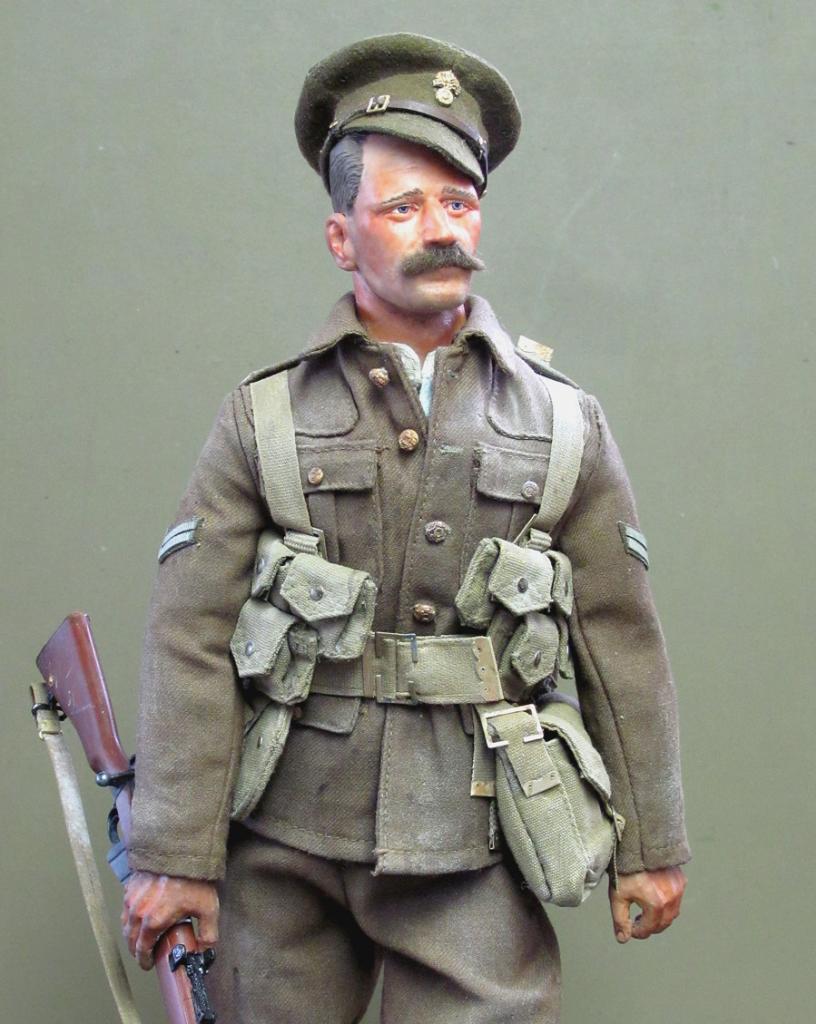MONS
Corporal, 4th Royal Fusiliers.MONS
Caporal, 4e Royal Fusiliers.
Ce week-end est le 100e anniversaire des premiers affrontements entre British Expeditionary Force, BEF, et l'armée impériale allemande autour de la ville belge de Mons.
Parmi les premiers bataillons d'être engagés, à 7h du matin, le 23 Août, a été le 4e royal des Fusiliers, un régiment de Londres. Ce bataillon contenait beaucoup d'hommes plus âgés qui étaient réservistes rappelés de leur emploi civil. Ils forment le centre de la position britannique, et défendu un pont essentiel dans le village de Nimy. Ils ont été contraints de se retirer par 14 heures, mais pas avant d'infliger de lourdes pertes sur les Allemands. Ils ont reçu deux VCs à la suite des combats de la journée, la première dans la Grande Guerre.
La figure utilise l'uniforme et l'équipement de l'at-Albert Brown figure, fortement modifiée.
This weekend is the 100th anniversary of the first clashes between British Expeditionary Force , the BEF , and the
Imperial German Army around the Belgian town of Mons.
The BEF arrived on the 21st , cavalry patrols clashed on the 22nd, and on the 23rd nine and a half British Battalions along a nine-mile front fought all day to hold off four German Divisions from von Kluck’s First Army. They inflicted appalling casualties on the very brave Germans , but were forced back by numbers.
This photo of the 4th Royal Fusiliers was taken in Mons on the 22nd. They look suitably hot and bothered.

Right in the centre , just north of Mons around the village of Nimy, the 4th RF were engaged defending an important bridge over the Canal du Centre , from about 7am until forced to withdraw around 2pm .Lieutenant Dease, their machinegun officer, won the first VC of the war holding off the Germans while the rest of the battalion made its withdrawal. He was wounded many times, and when he died his Maxim was taken over by Pvt. Sidney Godley,who was wounded and captured , and also given the VC .
The 4th Royal Fusiliers were reservists, and thus older than most regular soldiers , in their thirties rather than their twenties, having served their time with the colours but who were liable for recall in the event of war . They were experienced, steady men, but often out of condition. The campaign thereafter developed into a continuous fighting retreat , marching all day in very hot weather, with men suffering badly with sore feet .
 The figure :~
The figure :~This is mostly from DiD “Albert Brown”, his uniform subtly recoloured , and with new buttons , a new cap , improved equipment and a new rifle, a correct SMLE.Mk.III, with the volley sights and magazine cutoff.
I’ve made a limited batch of these in resin .I make my own putties from brushed cotton, which is much nearer the coarse woolen texture of the originals than the DiD tape versions .
He has photoetch shoulder titles for “ RF “ .

I’ve replaced all the coarse tape on the1908 webbing with something finer and more in scale . The cartridge pouches are still symmetrical , since it was during this campaign they discovered that the lower left hand set needed stronger fastenings, the clips falling out when men lay down or leant against a bank. For the rest of the war the left pouches were produced with an extra strap : anyone doing a Tommy from later in the war needs to bear this in mind .
The cap is still the stiff-topped variety, which didn’t outlast the autumn, being replaced by the “ Gor-Blimey “ soft trench cap in the coming winter.
He’s dumped his greatcoat as too much to carry, hence the near emptiness of his large pack. Doubtless, if he survives , he will have to pay for it , but just now he has other things to worry about...

The Royal Fusiliers had always been a London Regiment , based at the Tower, where their Museum , I believe, still exists.
Here they are forming at camp before being loaded on trains for embarkation .

This figure has gone to Taiwan for Weylen’s Taipei exhibition, hence the rather rushed pics.
*******************************************************************





